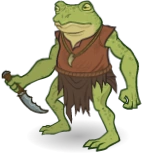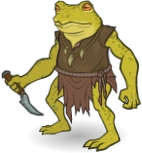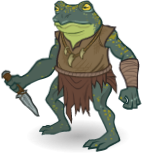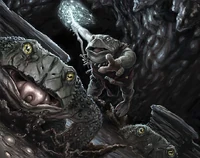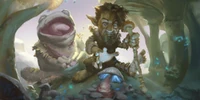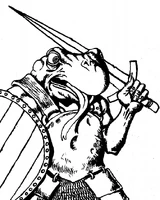Bullywugs were a primitive race of frog-like humanoids found throughout the bogs and marshes of Toril, the self-proclaimed lords of the swamp. Savage and self-destructive, the bullywugs regularly tampered with forces beyond their understanding, threatening the safety of others and their own brutish, noisome, and wet lives.[1][2][3]
Description[]
Bullywugs were amphibious humanoids with webbed digits[4] that stood between 5′4″‒6′ (1.6‒1.8 m) and weighed 150 to 240 pounds (68 to 110 kilograms) on average,[8] although they could vary in body type from 4 to 7 feet (1.2 to 2.1 meters) and 100 to 300 pounds (45 to 140 kilograms).[3][9]
Their hides were smooth and reasonably tough, with mottled coloration ranging from emerald or olive green, yellow, brown, and gray.[1][10][3][5] Bullywug skin was chameleon-like, so if they remained motionless in swampy terrain, they would shift through different hues and shades of their normal color range to match their surroundings.[1][3][4][5] The creatures were noxious to be around, for they carried with them the rancid reek of the bog.[2][9]
The huge heads of bullywugs resembled those of frogs, with big, bulbous eyes, wide mouths,[4][11] and long, flicking tongues. Said tongues were barely capable of navigating a stunted variant of Common, and they typically spoke in thick, sloppy accents.[3][9]
Personality[]
Bullywugs were foul inhabitants of the natural world both in smell and company,[2] constantly hungry savages[1] often completely lacking in higher emotions and feelings.[4] Unlike many other creatures of the wild, bullywugs either didn't understand or didn't care about the effect they had on their own ecosystems.[13] They hunted and killed for sport without the intelligence or discrimination to allow environmental recovery, and so systematically depleted the natural resources of their own habitats.[3]
Rather than fill any ecological niche, these habits made bullywugs a disruption and threat to the fragile balance they themselves relied upon, and after exhausting other food sources, they would either move on to greener pastures or turn to cannibalism (although some were cannibals by choice). While they didn't permanently poison the land like the undead, the effects of bullywugs left to their reckless practices was nothing short of disastrous for a few years, as they stripped acres of land bare[4][2][14] and left behind a despoiled morass of mud, a mere echo of a once fertile swamp.[2]
The bullywugs were not unaware of this phenomenon, the difference in environment before and after they entered being so noticeable that even they viewed their own presence as "off" somehow. This sense of something being wrong manifested as paranoia, the sense that everything was out to get them somehow, although this feeling was not exactly untrue. Those that struck the scourge of bullywugs with particular precision or power sometimes felt a moment of renewed strength or clarity, as if the natural world itself was thanking them for their service.[2]
Bullywugs were, appropriately enough, bullies,[3] and often their greatest joy came from lording over trespassers in their domains.[1] They believed themselves to be the true lords of the swamp and behaved as such,[1][15] being known to laze and loaf even as others worked.[16][17] They prized coins, jewels, and other treasures, although as individuals they lacked the same kind of greed and megalomania found in marauders like orcs. Infighting within the same group almost never occurred, though some would suggest this was due to a lack of brainpower rather than malice.[4] Regardless of the truth of that idea, bullywugs were easily confused,[15] the smartest of them normally being of about average human intelligence.[4]
Despite their tendencies towards chaotic and evil behavior, bullywugs were capable of adopting other behaviors. They often remained individualistic, but sometimes shed their more despicable traits when trying to find a place in the outside world.[18] Curiosity could drive them to explore,[19] and those that met success were the ones that learned to work with and rely on others, with most stray bullywugs being neutral and, on rare occasion, creatures of good.[18]
Abilities[]
Bullywugs could deliver powerful bites[1] and were creatures of notable athleticism.[2] The amphibians were strong swimmers able to move rapidly under the water, even when weighed down by things like armor or shields. Despite being slow on land, with or without objects encumbering them, bullywugs could hop as fast as they could run (and possibly faster), leaping 20 to 30 feet (6.1 to 9.1 meters) forward or 10 to 15 feet (3 to 4.6 meters) high in a single bound.[1][3][4][5]
A bullywug's camouflage protected them both from regular sight and from infravision since their body temperature changed along with their coloration to better blend with their surroundings.[5]
Some bullywugs, known as croakers, were flabby and weak compared to their kin, but able to belch up clouds of fetid, poisonous gas as they made their loud croaks.[2]
Combat[]
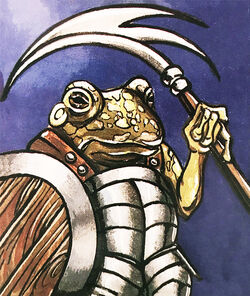
An armored bullywug with a shield and a peculiar-shaped weapon.
Bullywugs reserved their natural methods of defense (biting and to a lesser extent their pitiful "claws") for foes that got too close to them, preferring to wield weapons whenever possible.[1][4][5] Most were barely able to wield more than a simple stone weapon (such as a club),[11] so they stuck to spears, halfspears, and other sharp, piercing weapons that could be poked out of the water.[3] They normally leapt when in melee, since by springing through the air they increased the odds of hitting their foes, and when holding an impaling weapon, their strikes were twice as lethal. This made long weapons especially important, since they compensated for their slow speed when running and their exposed state when jumping.[4][5]
Bullywugs also wore crude armor and donned shields when available despite these things slowing them down when underwater, trying to equip themselves with at least leather armor as a point of pride.[3][4][18] This highlighted an oddity when it came to bullywugs, their illogical approach to battle. Bullywugs were fierce, aggressive creatures known to display fanatical loyalty to their tribes, and yet had little stomach for protracted fighting, which combined with their lacking minds made them somewhat unpredictable as far as combat went. Bullywugs were just as likely to fight to the death no matter how obviously doomed they were as they were to run for the hills after only a few of them fell, melting away into the swamp even if they easily could have won.[3][9][20]
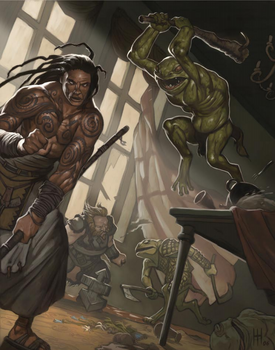
A bullywug brawl.
Bullywugs did not favor fair fights, and were skilled in the construction and use of nets and snares.[4] They preferred to fight in or near water,[3] and given their camouflage and ability to suddenly spring into action, they were adept ambushers.[4][5] Bullywugs were emboldened by superior numbers and always tried to overwhelm the enemy by surrounding them. They hated humans and attacked adventurers on sight whenever their own groups were larger, but against serious threats, they normally left in search of easier prey.[1][15][4] Fittingly, bullywugs usually tried to summon monsters as the first part of any attack whenever possible, but given their issues with that art, there was a 1/8 chance they would accidentally summon more creatures than expected, lose control, and then waste their efforts fighting their would-be aid.[3]
Most bullywugs outside of their homes trained as warriors while some became barbarians, the tribe's biggest bullywug often doing the latter.[3] Some bullywugs had specific strategies; those known as muckers were strong and stout foes that jumped at their victims to knock them prone before kicking them while they were down, while others known as twitchers erratically spasmed around the battlefield, making them difficult to hit and difficult to avoid.[2]
Society[]
Bullywug society was savage, primitive, and tribal, one of the most petty-minded and mindlessly destructive of all humanoid organizations.[2][4] Bullywugs had learned to cooperate for the sake of mutual survival and hunting benefit with practically zero infighting,[18][4] but murder was still one of the two primary methods for getting ahead. The killing of one's rivals had to be performed secretly however, since bullywugs who witlessly did away with their opposition were likely to be executed by the others. Bullywug politics were typically more "subtle" than killing whoever was in front on the social ladder.[1]
Aside from their gods, bullywugs only ever showed respect to their leaders, for their organized (or at least semi-organized) societies were socially fascist and so tyrannical as to be totalitarian. Absolute authority was vested to subleaders led by a male chieftain, a self-styled lord of the muck who could treat all his subjects as possessions and freely kill (and eat if he chose) his followers if they did not instantly follow his whims.[1][18][4] Only when the previous leader was too old to rule would the next dominant male kill and usurp (and possibly consume) him.[4]
This foul aristocracy formed the basis of bullywug "etiquette", both amongst themselves and outsiders. Bullywugs introduced themselves with grand titles while groveling and kowtowing before their superiors, ceaselessly competing to win their favor.[1] It was in this sycophantic competition that the bullywug love and hoarding of treasure became important despite its lack of actual use in their societal system.[18] Instead of killing each other, bullywugs could advance by finding treasures and trinkets (including magical items) to present to their lord as tokens of deference or loyalty.[1]
It was for this reason that bullywugs raided caravans and settlements, obtaining baubles and knickknacks to impress and win over their masters. Even if this succeeded and a bullywug got into the good graces of their leaders, the careless abuse and neglect that they so commonly showed their own property invariably meant that the fine items they acquired would become broken and dirty, whereupon the bullywug lord would invariably demand even more. Capturing intruders was favorable to just killing them because they could be dragged before the bullywug kings and their queens and forced to beg for mercy.[1]
Bullywug royals were sneering and demanding, donning robes of leather, rough cloth, and marsh plants[1][21] even as most bullywugs wore no clothes.[4] Through bribery and flattery they could be convinced to release their captive audience, but not before trying to impress them with the majesty of their realm and the grandeur of their treasures.[1] Despite claims of being the masters of the marshes, bullywugs recognized their adverse environmental influence and perceived themselves negatively because of it, and that attitude extended to the bullywug lords.[1][2] Behind their pretensions to nobility and fanciful posturing was a deep inferiority complex, a desperate desire for legitimacy in the eyes of outsiders as beings worthy of not only fear, but respect.[1]
Numbers[]
Bullywugs normally appeared in groups somewhere between ten to eighty individuals,[4] although they traveled in their tribal groups in numbers somewhere below fifty.[10] A grouping of four bullywugs was known as a "pad", a pair of pads was called a "float", and between two to six floats was a "pond".[3] Bullywug bands always had large leaders, with communities of thirty or more possessing five subleaders and groups of sixty or more having a great chieftain and five subchieftans.[4][5]
Discrimination[]
A small number of bullywugs were bigger and smarter than their peers, being broader than their relatives and ranging in height from 6 to 7 feet (1.8 to 2.1 meters). These "advanced" bullywugs were also more organized, more well-equipped, and more aggressive than the normal variety, staking out regular territories varying with the group size. Advanced bullywugs dwelt in abandoned buildings and caves, sent out regular patrols and hunting parties, and unlike normal bullywugs, were able to wear armor and use weaponry with little trouble. They regularly raided outside territory for food and plunder, particularly enjoying human flesh.[4][5][18][11]
The presence of advanced bullywugs was one of the few times that bullywugs fought. Normal bullywugs hated their larger, more intelligent kin with a passion, going to war with them every chance they got.[4][18][5] Advanced bullywugs reciprocated the feeling, viewing all outsiders, bullywugs or otherwise, as either threats or food sources. Despite this hatred,[4] it was the largest and smartest bullywugs that invariably led bullywug kind,[21] the kings and queens of their race normally being of unusual stature.[1] On the other side of the coin, it was the advanced bullywugs that most frequently broke away from their kind and took up the adventuring lifestyle.[18][11]
Often it was the females of bullywug society that decided to leave their lairs. Despite the fact that females and young made up about half of a given tribe, neither was given much weight in the social order, for their culture was heavily patriarchal. Females were looked down upon as nothing more than egg bearers, and these extremely limited options for advancement pushed them to a life of adventure.[4][18]
Relations[]
Bullywugs had difficulties allying with other beings, but when they did it was universally with the foul and the feral.[2] While there was no open hostility between the two, lizardfolk rarely associated with them,[5] and bullywugs were known to boss them around if given the chance.[15] The sahuagin held them in contempt and occasionally raided their lairs out of hateful malice before eating captives alive.[5] They fancied wemic claws as shield and armor decorations.[23]
Bullywugs were normally around the same size and color as gripplis, were known to abuse this fact to set ambushes, and in some cases were ancient enemies.[24] The bullywugs that lived within the Marsh of Chelimber believed they were in a never-ending battle with the sivs over control of the edge of the wetlands. In truth, the sivs emerged victorious in the conflict and allowed the ravenous amphibians to live within their realm, serving as a buffer between them outsiders from beyond the marsh. Only in places throughout the Realms too small for the sivs' desired isolation could the bullywugs truly lord over their sinkholes without interference from their more organized cousins.[3]
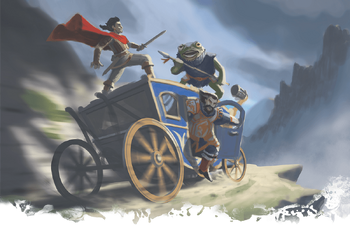
A bullywug bodyguard defends the villainous master of a baker's guild on a speeding carriage.
While most bullywugs hated humans and most humans (and other humanoids) feared and hated them in return,[18] bullywugs would readily serve wicked masters, even human ones.[5] Those that grew accustomed to working with others and seeing others of different races consistently pass, at the very least didn't attack on sight.[15] Most bullywugs lived out in the open, with loose territorial boundaries that they inefficiently enforced, though intruders often ended up killed and eaten.[4] They reportedly had no sense of privacy or personal space, and when they did have specific living spaces (such as huts) they were not known to be assigned to specific areas.[25]
Language[]
Bullywugs had access to the Batrachian Common tongue (a language used by frog-like humanoids),[24] and the more intelligent ones could speak a fractured form of Common with limited vocabulary,[4] but they had a primitive language of their own.[1] The bullywug tongue consisted of a series of croaks, staccato notes, and clicks,[1][7] and though crude, it allowed them to communicate over large distances, spreading news quickly across the swamps.[1]
Animal Taming[]
Bullywug language allowed for the communication of simple concepts with amphibians, a capability bullywugs used to form strong bonds with giant frogs and toads. They trained them to serve as guardians, hunters, and in the case of larger varieties, mounts, and used their ability to swallow creatures whole to carry prey back to their villages.[1] They were known to raise such creatures as tadpoles, and weren't bothered by them.[25] Furthermore, they were the undisputed masters of capturing and training wild frogs, and while swamp-dwelling kobolds and goblins had managed to learn from them, only the bullywugs had learned to truly domesticate them, using them like dogs. Sometimes trained war frogs were offered as gifts to set up trade relations with other tribes.[26]
Bullywugs were also known to ride giant leeches.[27]
Religion[]
Clerics and shamans were common among the bullywugs, with as many as ten percent of those in a community having access to divine magic (varying based on how advanced they were).[3][4][5] However, the greater number of bullywug priests came at the cost of their individual quality; they had access to only three kinds of magic, spells taken from their divine domains (typically from Chaos, Evil or Water), inflict spells, and summoning spells, the latter being culturally favored. Bullywug clerics were infamous, in fact, for their powerful yet unpredictable summonings, having made a religious fetish out of calling creatures that might or might not stay within their control.[3]
In any case, bullywug religion was not based on their past, at least not in any objectively verifiable way. They had only the most primitive of origin myths that ignored anything outside their own limited perceptions of their lives and environments.[28] Often they claimed to have been created by ancient primordials rather than deities, a claim of tenuous accuracy. The only power exclusive to the bullywugs was Ramenos, a god (or possibly primordial) of intoxication, rest, and decline.[2][28][29] Even so, the bullywugs had no creation myth involving Ramenos,[28] and even those who followed him didn't necessarily have anything more than the shallowest understanding.[30]
Ramenos had no clerics, only shamans, and those shamans were both crude and weak. They had no duties save for helping the leaders of the tribe (to whom they were often related) and to regularly take plant-based alkaloids to become intoxicated. Conversely, Ramenos gave practically no aid, sending neither omens nor avatars unless someone conducted a ritual at one of his ancient temples.[28] Given his utter lack of support and seeming indifference to his own increasing irrelevance, it was questionable if Ramenos was even still alive (with many not even being sure if he existed in the first place).[28][29][30]
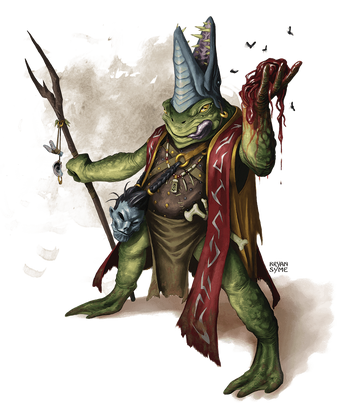
Pharblex Spattergoo, bullywug shaman.
Regardless of if Ramenos created them or not, bullywugs worshiped a host of noxious "gods" (some of which weren't even close to being divine), and much of their spiritual understanding was flawed.[2][3][31] For example, the cruelest of bullywugs believed that by creating legacies of savage violence for themselves, they might one day be reborn as slaadi.[2] When bullywug tribes came across a froghemoth, they would treat the monstrosity as a divine being and try to coax it into their den by communicating basic ideas and offering it food. These froghemoths might only eat a few bullywugs before following the others and could then be "tamed" with the bullywugs giving it a comfortable lair and food as tribute, while fanatically protecting it and any young froghemoth while it matured (which was fortunate considering that froghemoths had a tendency to eat their offspring.[31]
Bullywugs were also known to worship such vile entities as the obyrith demon lord Dagon, the Great Old One Ghaunadaur, or the ancient goddess of darkness Shar, although that didn't mean they did so in any official capacity. In reported cases, their "religion" was known to be personally manufactured, self-taught, and based on the individual desires and goals of the devotee. Even those that could actually use divine magic might have just assembled a hodgepodge of confused dogma, combining anything from strange hallucinogens, imagined lore, borrowed iconography, and copied elements of mysticism without actual understanding of that entity's tenets.[30][32][33]
Bullywug shamans that took up the life of an adventurer were usually those fleeing their god's wrath, and so often took up service to a new deity.[18]
Magic[]
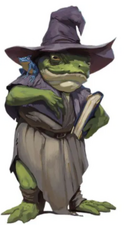
A bullywug spellcaster.
Some bullywugs, known as mud lords, possessed greater intelligence than their kin and were able to cast spells. They emitted fiery croaks and blasted their foes with their own electric reflux, although this magic was more powerful if they sacrificed their allies by containing them in the blast radius.[3]
On rare occasion, bullywugs were born with the innate, bardic power to weave magic into their songs. Among the most arrogant and pompous of their kind, they were raised in protected enclaves and taught how to heal and harm with their powers. Known powers included the ability to sing an ode to an elder froghemoth and grant temporary life force to bullywugs nearby, and to sing a song of marshy doom to psychically injure surrounding enemies.[21]
Biology[]
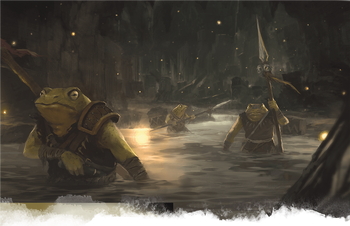
Bullywugs wandering through Slitherswamp, the 8th level of the Undermountain.
Bullywugs preferred to inhabit dark, dank places isolated far from human beings, wet locations like rainforests, damp caves, swamps, meres, or virtually any other warm but shady region with abundant water.[1][3][4][5] They had adapted for easy movement among the trees,[24] with soft, suction-cupped fingers,[20] and had no difficultly moving through mud and wetlands[3] on their webbed feet.[4] Bullywugs had to routinely soak their entire bodies to keep their skin moist, at least three times a day with an average waterskin's worth of water. If unable to regularly hydrate, they would slowly weaken and die, hence why bullywugs feared dry heat and areas with little standing water.[1][4][18][11][5]
Bullywugs slept in a frog-like fashion, burying themselves up to the eyes in pits of mud. At night, they were known to crowd on top of each other until everyone in that group was squeezed in, with multiple piles of bullywugs visible throughout their sleeping grounds.[25]
Diet[]
Bullywugs were mainly carnivorous and preferred a diet of meat.[4] They lived primarily off of fish and any other game (being skilled hunters and fisherman) and would supplement a diet of fruit and insects with flesh whenever possible.[4][24] Extremely young salt dragons, which dwelt in salt flats, lakes, and marshes, were cautiously hunted for food as well.[34]
A particular point of interest regarding bullywugs, as discovered by Brother Twick of Verdusk, a halfling cleric of Chauntea, was that they were irresistibly drawn to human liquor. After consuming large quantities, they would begin to convulse, helplessly falling prone on the ground for several minutes. The contractions ended with the bullywugs either dying or lapsing into a deep coma, depending on the amount of the alcoholic beverage they consumed. Bullywug attacks had become increasingly rare in the lands surrounding territories where settlements kept an ale or two in case of bullywug raids.[20]
Reproduction[]
Bullywugs were not known to bond in the long-term. Females would lay a clutch of 200 or so eggs once a year, which would be watched over by the collective tribe in a breeding pond. The non-intelligent spawn that hatched resembled large tadpoles and would feed upon insects and small amphibians (including each other) until they were large enough to leave the breeding pool, usually after about six to eight weeks. Following their emergence, the juvenile bullywugs were forced to fend for themselves, with nothing to rely upon but luck and their own strength against their larger kin. Unfortunately for them, this brutal "parenting" meant that less than one percent of bullywugs reached adulthood.[10]
There were rumors that (despite their hatred of humanity) bullywug-human hybrids were viable. Such degenerate humans certainly dwelled in mixed communities, serving unnamed things deep below the earth.[5]
Anatomy[]
Puncturing a bullywug's throat pouch without killing it would cause it to suck and noisily dribble whenever they breathed heavily.[35]
History[]
In the Days of Thunder, circa -33500 DR, long before the appearance of elves, giants, or even dragons, the amphibious creator race known as the batrachi ruled the supercontinent of Merrouroboros.[37][38] After the sarrukh fell into a state of somnolent inactivity, the rise of the batrachi ensured that their descendants, the snake-human hybrids known as the yuan-ti, would never reach the same level of prominence.[39] The batrachi worshiped Ramenos, who in these days was strong and active, and evidence of his dominion could still be found deep within jungles and lost plateaus where his ruins temples stood. Huge stone statues of the amphibian power dominated plazas and open areas around main buildings, his massive maw open to swallow sacrifices.[28]
The batrachi reached the height of the power in -31500 DR under the leadership of The High One Zhoukoudien, but their dominion was threatened by the Jotunbrud, who Zhoukoudien had went to war with. His reign ended around that time when he was slain by the titan thane Omo. In the final days of their civilization, circa -31000 DR, the desperate batrachi performed a ritual of epic summoning to defeat Annam's titan armies, releasing several imprisoned primordials, including the Creator of Dragonkind, Asgorath. Unfortunately for the batrachi, the battle between the gods and the primordials unleashed unimaginable catastrophe across all of Toril. Continent-sized chunks of land fell into the ocean as the seas were rearranged, while earthquakes, windstorms and terrible fires scourged the entire planet.[37][40]
The climax of this devastating tumult was the Tearfall, when comets and/or a moon of ice (suspected to have been hurled by Asgorath) crashed into Toril, merging the four Inner Seas into the Sea of Fallen Stars, and soon after tens of thousands of dragon eggs would hatch across the planet. An entity calling itself a batrachi lord spoke of the blanketing of the land with ice as the seven-turn winter, and the dramatic change in climate rendered the world uninhabitable for the batrachi. Forced to retreat from the fallout, the batrachi fled to Limbo, where they were changed for at least the second time by Ramenos to suit his purposes (with many confusing the batrachi for slaadi).[37][40]
Back on Toril however, remnants of the batrachi lineage still remained. Spawned from their union with races of proto-amphibians were the degenerate descendants of the batrachi race that once ruled Toril—the bullywugs.[28]
Notable Bullywugs[]
- Karimsh, a shaman and swarm leader of a group that attacked the Elfmaid in the Sea of Swords.[7]
- Rhacoph, a fat and lazy vampire that broke away from the Blacktongue tribe and turned to the worship of Shar.[33]
Gallery[]
Appendix[]
Appearances[]
Adventures
Novels & Short Stories
Video Games
Board Games
Card Games
Organized Play & Licensed Adventures
External Links[]
 Bullywug article at the Eberron Wiki, a wiki for the Eberron campaign setting.
Bullywug article at the Eberron Wiki, a wiki for the Eberron campaign setting.
References[]
- ↑ 1.00 1.01 1.02 1.03 1.04 1.05 1.06 1.07 1.08 1.09 1.10 1.11 1.12 1.13 1.14 1.15 1.16 1.17 1.18 1.19 1.20 1.21 1.22 1.23 1.24 1.25 1.26 1.27 Mike Mearls, Jeremy Crawford, Christopher Perkins (2014-09-30). Monster Manual 5th edition. Edited by Scott Fitzgerald Gray. (Wizards of the Coast), p. 35. ISBN 978-0786965614.
- ↑ 2.00 2.01 2.02 2.03 2.04 2.05 2.06 2.07 2.08 2.09 2.10 2.11 2.12 2.13 2.14 2.15 2.16 Rob Heinsoo, Stephen Schubert (May 19, 2009). Monster Manual 2 4th edition. (Wizards of the Coast), pp. 28–29. ISBN 0786995101.
- ↑ 3.00 3.01 3.02 3.03 3.04 3.05 3.06 3.07 3.08 3.09 3.10 3.11 3.12 3.13 3.14 3.15 3.16 3.17 3.18 3.19 3.20 3.21 3.22 3.23 3.24 3.25 3.26 3.27 3.28 3.29 3.30 James Wyatt, Rob Heinsoo (February 2001). Monster Compendium: Monsters of Faerûn. Edited by Duane Maxwell. (Wizards of the Coast), p. 25. ISBN 0-7869-1832-2.
- ↑ 4.00 4.01 4.02 4.03 4.04 4.05 4.06 4.07 4.08 4.09 4.10 4.11 4.12 4.13 4.14 4.15 4.16 4.17 4.18 4.19 4.20 4.21 4.22 4.23 4.24 4.25 4.26 4.27 4.28 4.29 4.30 4.31 4.32 4.33 4.34 4.35 4.36 4.37 4.38 Doug Stewart (June 1993). Monstrous Manual. (TSR, Inc), p. 34. ISBN 1-5607-6619-0.
- ↑ 5.00 5.01 5.02 5.03 5.04 5.05 5.06 5.07 5.08 5.09 5.10 5.11 5.12 5.13 5.14 5.15 5.16 5.17 Don Turnbull (1981). Fiend Folio. (TSR Hobbies), pp. 16–17. ISBN 0-9356-9621-0.
- ↑ Carl Sargent (May 1992). Monster Mythology. (TSR, Inc), p. 101. ISBN 1-5607-6362-0.
- ↑ 7.0 7.1 7.2 Elaine Cunningham (April 2003). Windwalker (Hardcover). (Wizards of the Coast), p. 47. ISBN 0-7869-2968-5.
- ↑ Rob Heinsoo, Stephen Schubert (May 19, 2009). Monster Manual 2 4th edition. (Wizards of the Coast), p. 220. ISBN 0786995101.
- ↑ 9.0 9.1 9.2 9.3 Nicolas Logue (November 2006). “The Bullywug Gambit”. In James Jacobs ed. Dungeon #140 (Paizo Publishing, LLC) (140)., p. 33.
- ↑ 10.0 10.1 10.2 James Butler, Elizabeth T. Danforth, Jean Rabe (September 1994). “The Cormyrean Marshes”. In Karen S. Boomgarden ed. Elminster's Ecologies (TSR, Inc), p. 12. ISBN 1-5607-6917-3.
- ↑ 11.0 11.1 11.2 11.3 11.4 Douglas Niles (1995). Player's Option: Skills & Powers. (TSR, Inc), p. 41. ISBN 0-7869-0149-7.
- ↑ Paul S. Kemp (July 2003). Twilight Falling. (Wizards of the Coast). ISBN 0-7869-2998-7.
- ↑ James Butler, Elizabeth T. Danforth, Jean Rabe (September 1994). “The Cormyrean Marshes”. In Karen S. Boomgarden ed. Elminster's Ecologies (TSR, Inc), p. 9. ISBN 1-5607-6917-3.
- ↑ James Butler, Elizabeth T. Danforth, Jean Rabe (September 1994). “The Cormyrean Marshes”. In Karen S. Boomgarden ed. Elminster's Ecologies (TSR, Inc), p. 12. ISBN 1-5607-6917-3.
- ↑ 15.0 15.1 15.2 15.3 15.4 Wolfgang Baur, Steve Winter (August 2014). Hoard of the Dragon Queen. Edited by Miranda Horner. (Wizards of the Coast), p. 47. ISBN 978-0786965649.
- ↑ Wolfgang Baur, Steve Winter (August 2014). Hoard of the Dragon Queen. Edited by Miranda Horner. (Wizards of the Coast), p. 51. ISBN 978-0786965649.
- ↑ Wolfgang Baur, Steve Winter (August 2014). Hoard of the Dragon Queen. Edited by Miranda Horner. (Wizards of the Coast), p. 54. ISBN 978-0786965649.
- ↑ 18.00 18.01 18.02 18.03 18.04 18.05 18.06 18.07 18.08 18.09 18.10 18.11 18.12 Bill Slavicsek (1993). The Complete Book of Humanoids. (TSR, Inc), pp. 22–24. ISBN 1-5607-6611-5.
- ↑ James Butler, Elizabeth T. Danforth, Jean Rabe (September 1994). “Explorer's Manual”. In Karen S. Boomgarden ed. Elminster's Ecologies (TSR, Inc), p. 8. ISBN 1-5607-6917-3.
- ↑ 20.0 20.1 20.2 James Butler, Elizabeth T. Danforth, Jean Rabe (September 1994). “The Cormyrean Marshes”. In Karen S. Boomgarden ed. Elminster's Ecologies (TSR, Inc), p. 13. ISBN 1-5607-6917-3.
- ↑ 21.0 21.1 21.2 Mike Mearls, Kate Welch (May 2019). Ghosts of Saltmarsh. Edited by Kim Mohan. (Wizards of the Coast), p. 232. ISBN 978-0-7869-6686-8.
- ↑ 22.0 22.1 Elaine Cunningham (April 2003). Windwalker (Hardcover). (Wizards of the Coast). ISBN 0-7869-2968-5.
- ↑ James Butler, Elizabeth T. Danforth, Jean Rabe (September 1994). “The Settled Lands”. In Karen S. Boomgarden ed. Elminster's Ecologies (TSR, Inc), p. 30. ISBN 1-5607-6917-3.
- ↑ 24.0 24.1 24.2 24.3 Frank Mentzer (1987). Needle. (TSR, Inc), pp. 2–5. ISBN 0-88038-386-0.
- ↑ 25.0 25.1 25.2 Wolfgang Baur, Steve Winter (August 2014). Hoard of the Dragon Queen. Edited by Miranda Horner. (Wizards of the Coast), p. 50. ISBN 978-0786965649.
- ↑ Mike Mearls, Greg Bilsland, Robert J. Schwalb (June 2010). Monster Manual 3 4th edition. Edited by Greg Bilsland, et al. (Wizards of the Coast), p. 90. ISBN 978-0-7869-5490-2.
- ↑ slade, et al. (April 1996). “The Wilderness”. In James Butler ed. The North: Guide to the Savage Frontier (TSR, Inc.), p. 36. ISBN 0-7869-0391-0.
- ↑ 28.0 28.1 28.2 28.3 28.4 28.5 28.6 Carl Sargent (May 1992). Monster Mythology. (TSR, Inc), pp. 98, 101. ISBN 1-5607-6362-0.
- ↑ 29.0 29.1 Mike Mearls, Brian R. James, Steve Townshend (July 2010). Demonomicon. Edited by Scott Fitzgerald Gray. (Wizards of the Coast), p. 76. ISBN 978-0786954926.
- ↑ 30.0 30.1 30.2 Wolfgang Baur, Steve Winter (August 2014). Hoard of the Dragon Queen. Edited by Miranda Horner. (Wizards of the Coast), p. 61. ISBN 978-0786965649.
- ↑ 31.0 31.1 Mike Mearls, et al. (November 2016). Volo's Guide to Monsters. Edited by Jeremy Crawford, et al. (Wizards of the Coast), p. 145. ISBN 978-0786966011.
- ↑ Nicolas Logue (November 2006). “The Bullywug Gambit”. In James Jacobs ed. Dungeon #140 (Paizo Publishing, LLC) (140)., p. 44.
- ↑ 33.0 33.1 Toni Winslow-Brill (2018). Fangs and Frogs (DDAL08-09) (PDF). D&D Adventurers League: Waterdeep (Wizards of the Coast), pp. 6, 8.
- ↑ Richard Alan Lloyd (June 1998). “The Missing Dragons”. In Dave Gross ed. Dragon #248 (TSR, Inc.), p. 28.
- ↑ Nicolas Logue (November 2006). “The Bullywug Gambit”. In James Jacobs ed. Dungeon #140 (Paizo Publishing, LLC) (140)., p. 42.
- ↑ Brian R. James, Ed Greenwood (September 2007). The Grand History of the Realms. Edited by Kim Mohan, Penny Williams. (Wizards of the Coast), p. 5. ISBN 978-0-7869-4731-7.
- ↑ 37.0 37.1 37.2 Brian R. James, Ed Greenwood (September 2007). The Grand History of the Realms. Edited by Kim Mohan, Penny Williams. (Wizards of the Coast), pp. 5, 8. ISBN 978-0-7869-4731-7.
- ↑ Ed Greenwood, Eric L. Boyd, Darrin Drader (July 2004). Serpent Kingdoms. (Wizards of the Coast), p. 186. ISBN 0-7869-3277-5.
- ↑ Ed Greenwood, Eric L. Boyd, Darrin Drader (July 2004). Serpent Kingdoms. (Wizards of the Coast), p. 97. ISBN 0-7869-3277-5.
- ↑ 40.0 40.1 Bruce R. Cordell, Ed Greenwood, Chris Sims (August 2008). Forgotten Realms Campaign Guide. Edited by Jennifer Clarke Wilkes, et al. (Wizards of the Coast), pp. 41–42. ISBN 978-0-7869-4924-3.

